Wave Formula – Definition, Equations, Characteristics, Properties, Types, Symptoms and Example Questions
In this modern era, technology has become important. Technology can make work easier and shorten actual distances of thousands of miles, for example by using the telephone. One of the important things that supports the existence of technology is the means, for example energy or waves as a medium.

Many electronic items utilize the properties of waves, for example the nature of waves that can propagate Humans use vacuum to make light bulbs where the space inside the bulb is space empty.
There are many electronic devices around us whose technology uses waves, but most of us don't fully know and understand them. And we will discuss the use of waves and sound waves in everyday life more specifically in the next chapter.
Also read articles that may be related: Electromagnetic wave
Understanding Waves
Wave is a propagating vibration, in its propagation the wave carries energy. In other words, waves are vibrations that propagate and the vibrations themselves are the source of the waves. So, waves are vibrations that propagate and moving waves will propagate
energy (power). Waves can also be interpreted as a form of vibration that propagates in a medium.In waves, it is the wave that propagates, not the intermediate medium. The length of one wave can be seen by calculating the distance between valleys and hills (transverse waves) or calculating the distance between one density and one gap (longitudinal waves). The speed of wave propagation is the distance traveled by the wave in one second.
Wave Equation
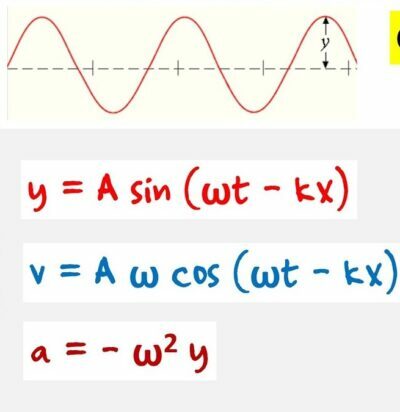
Information:
A = amplitude
k = wave number (wave constant)
ω = angular speed
y = Wave deviation (m)
v = Wave propagation speed (m/s)
a = Wave acceleration (m/s²)
Wave Formula
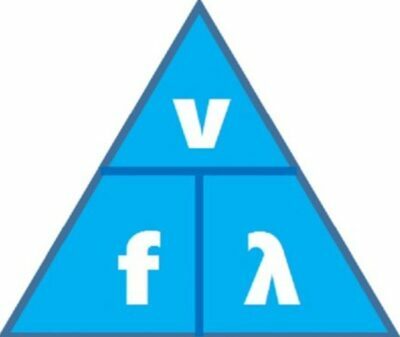
Determining Frequency, Period and Wavelength

Wave Refraction

Also read articles that may be related: Understanding Telescope
Wave Characteristics
The following are several characteristics of waves, consisting of:
- Can Be Reflected or Mirrored
You are familiar with this wave reflection event when studying geometric optics. In class x, in this event the Law of reflection according to Snellius applies. - Can be refracted (refraction)
Refraction can occur when waves pass through two different media. - Can be Flexed (Diffraction)
Diffraction (bending) occurs when waves pass through a narrow gap. - Can be Combined or Combined (Interference)
Wave interference occurs when two waves come together (combine) to produce a maximum and minimum interference pattern. - Can Be Polarized (Polarization)
Polarization is the event that part or all of the direction of wave vibrations is absorbed. This polarization event only occurs in transverse waves. - Can be Decomposed (Dispersion)
Why is the sky blue?? This is because sunlight experiences dispersion symptoms. The sunlight you see is white, but it actually consists of red, orange, yellow, green, blue, indigo and violet rays. This happens when the sky appears blue when you look at a white whiteboard, meaning all the color pigments are reflected into our eyes.
Wave Properties
The following are several properties of waves, consisting of:
1. Properties of Sound Waves
- Sound waves require a medium to propagate
Because sound waves are mechanical waves, sound requires a medium to propagate. This can be proven when two astronauts are far from Earth and the atmosphere in the plane is empty air, the astronaut cannot have a direct conversation but uses communication tools such as telephone. Even though the two astronauts were in the same plane. The ability of a medium to vibrate particles varies, there are even mediums that can dampen sound, for example water. - Sound waves experience reflection (reflection)
One of the properties of waves is that they are reflected, so sound waves can also experience this. The law of wave reflection: angle of incidence = angle of reflection also applies to sound waves. It can be proven that the reflection of sound in a closed space can cause echoes. That is, some of the reflected sound coincides with the original sound so that the original sound sounds unclear. To avoid echoes in cinemas, studios, radio, television and concert halls music, the walls are covered with a sound dampening substance which is usually made from wool, cotton, glass, rubber or iron. - Sound Waves Experience Refraction (Refraction)
One of the properties of waves is that they undergo refraction. Refraction events in everyday life, for example, at night the sound of thunder is louder than during the day. This is because during the day the air in the upper layers is cooler than in the lower layers. Because the speed of sound at cold temperatures is smaller than at hot temperatures, the speed of sound in layers of air The top layer is smaller than the bottom layer, which results in the top layer medium being denser than the layer medium lower. The opposite happens at night. So during the day the sound of lightning propagates from the upper air layer to the lower air layer. If the incoming sound travels vertically downwards, at night, the direction of sound propagation is biased closer to the normal line. It is best that during the day the direction of sound propagation is refracted away from the normal line. In accordance with the law of wave refraction, waves coming from a less dense medium to a denser medium will be refracted closer to the normal line or vice versa. - Sound Waves Experience Bending (Diffraction)
Sound waves experience diffraction very easily because sound waves in air have wavelengths in the range of centimeters to several meters. Diffraction is the bending of waves when they pass through a gap, the size of the gap is on the order of the wavelength. As we know, longer waves are more easily diffracted. Diffraction events occur, for example, when we can hear the sound of a car engine at a road bend even though we haven't seen the car because it is blocked by a tall building at the edge of the bend. - Sound Waves Experience Combination (Interference)
Sound waves experience symptoms of wave combination or interference which can be divided into two, namely construction interference or sound strengthening and destructive interference or sound weakening. For example, when we are between two loudspeakers with the same or almost the same frequency and amplitude, we will hear loud and weak sounds alternately. - Sound Waves Experience Sound Propagation
The interference caused by two sound waves can cause sound propagation events, namely sound strengthening and weakening. This occurs due to the superposition of two waves that have slightly different frequencies and propagate in the same direction. If the two sound waves propagate at the same time, they will produce the strongest sound when both phases are the same. If the two vibrations are in opposite phase, the weakest sound will be produced.
Also read articles that may be related: “Intensity” Definition & (Application of Sound Waves)
2. Properties of Light Waves
- Light Waves Experience Interference
Light waves, like sound waves, can interfere. To obtain light interference, a coherent light source is needed, namely a light source that has the same frequency and a fixed phase difference. Coherent light sources can be observed from experiments carried out by Young and Fresnell. Light interference can produce dark light patterns. Dark patterns result from destructive interference (attenuating each other) due to the merger of two waves that have opposite phases. The bright pattern results from construction interference (mutual reinforcement) due to the combination of two waves that have the same phase. - Light Waves Experience Diffraction
Wave diffraction is the process of wave bending caused by the presence of a barrier in the form of a gap or corner barrier that blocks part of the wave front. Light diffraction also occurs in separate narrow slits parallel to each other at the same distance. The narrower the gap is called a diffraction grating, the more gaps there are in a grating. The sharper the diffraction pattern produced on the screen. Maximum difarfraction occurs when bright lines appear on the screen. The diffraction pattern also formed by a round slit consists of a central bright shape surrounded by light and dark rings. - Light Waves Experience Polarization
Polarization is the process of filtering the direction of vibration of a wave. This tool for filtering the direction of vibration is called Polaroid. One example is crystals. Polarization is also found in reflection and refraction and in double refraction. The absorption and reflection of light by particles is called scattering. If unpolarized light comes into a medium (gas) the scattered light can be partially or completely polarized. The direction of polarization is such that it is perpendicular to the plane formed by the line of incident light and the line of sight.
3. Properties of Electromagnetic Waves
- Changes in the electric field and magnetic field occur at the same time.
- The directions of the electric field and magnetic field are perpendicular to each other.
- The electric and magnetic field strengths are directly proportional to each other, namely according to the relationship E = c. B.
- The direction of propagation of electromagnetic waves is always perpendicular to the direction of the electric field and magnetic field.
- Electromagnetic waves can propagate in a vacuum.
- Electromagnetic waves propagate at a rate that depends only on the electrical and magnetic properties of the medium.
- The speed of propagation of electromagnetic waves in vacuum is a general constant and its value is = 3 x 108 m/s.
- Electromagnetic waves are transverse waves.
- Electromagnetic waves can experience the processes of reflection, refraction, polarization, interference and diffraction (bending).
Types of Waves
The following are several types of waves, consisting of:
1. Based on the Medium
- Mechanical waves, is a wave which in its propagation requires a medium, which channels energy for the propagation process of a wave. Sound is an example of a mechanical wave that propagates through changes in air pressure in space (the density of air molecules).
- Electromagnetic wave, namely waves that can propagate even if there is no medium. Electromagnetic energy propagates in waves with several characteristics that can be measured, namely: wave length, frequency, amplitude and speed.
Sources of Electronmagnetic Waves are as follows:
- Electrical Oscillations
- Sunlight produces infrared rays
- Mercury lamps that produce ultra violet
- The shooting of electrons in a vacuum tube at a metal chip produces X-rays (used for X-rays) and unstable atomic nuclei produce gamma rays.
Examples of electronmagnetic waves in everyday life are as follows:
- Radio Wave
- Microwaves
- Infrared rays
- Ultraviolet light
- Visible light
- X-rays and
- Gamma rays
Also read articles that may be related: “Ultrasonic Sound Waves” Limit Human Hearing & (Benefits of Reflection in Daily Life)
2. Based on the direction of propagation and vibration
Consists of:
- Transverse waves
namely waves whose direction of propagation is perpendicular to the direction of vibration. An example of a transverse wave is a string wave. When we move the rope up and down, it appears that the rope moves up and down in a direction perpendicular to the direction of the wave motion.
The highest point of the wave is called peak while the lowest point is calledvalley. Amplitude is the maximum height of a peak or maximum depth of a valley, measured from the equilibrium position. The distance from two equal and consecutive points on a wave called wavelength(called lambda – Greek letter). Wavelength can also be thought of as the distance from peak to peak or distance from valley to valley.
- Longitudinal waves
namely waves whose direction of propagation is parallel to the direction of vibration (for example slinky waves). The waves that occur in the vibrating slinki are in the same direction as the slinki's length in the form of density and strain. The distance between two adjacent densities or two adjacent strains is called one wave.
A series meeting And strain propagates along the spring. Meeting is the area where the spring coils approach each other, whereas strain is the area where the spring coils are facing away from each other. If transverse waves have a pattern of peaks and valleys, then longitudinal waves consist of a pattern of density and strain. Wavelength is the distance between successive densities or successive strains. What is meant here is the distance from two identical and consecutive points of density or strain.
Wave Symptoms
The following are several wave symptoms, consisting of:
- Reflection
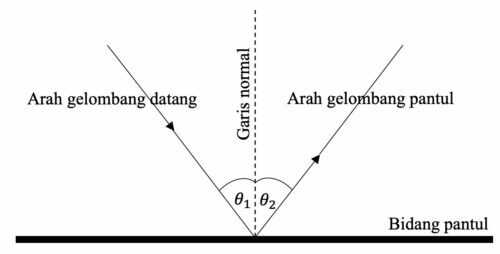
At events wave reflection The law of wave reflection will apply, namely the angle of reflection is the same as the angle of incidence. This means that when the incident wave beam forms an angle θ with the normal line (a line perpendicular to the reflecting surface), then the reflected beam will form an angle θ with the normal line.
- Wave Refraction
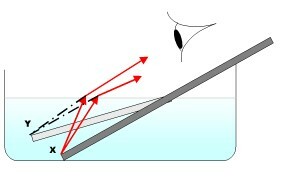
Wave refraction (refraction) is the deflection of the direction of a wave front when it enters from one medium to another. Sometimes refraction and reflection occur simultaneously. When incoming waves hit another medium, some of the waves will be reflected and others will be transmitted or refracted. Refraction occurs because waves have different speeds in different media.
- Interference
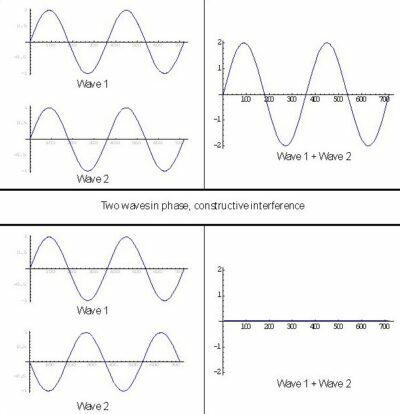
Wave interference is the fusion or superposition of waves when two or more waves arrive at the same place at the same time. The interference of two waves can produce waves whose amplitudes reinforce each other (interference maximum) and can also produce waves whose amplitudes attenuate each other (interference minimum).
- Wave Diffraction
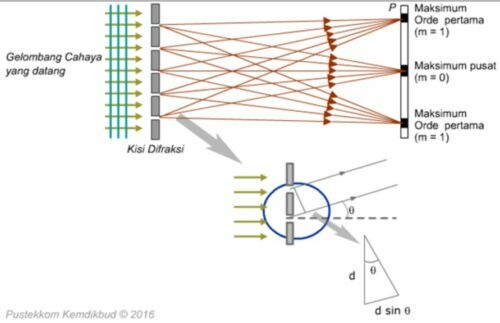
Wave diffraction is the event of a wave bending when it passes through a narrow gap or barrier.
In the same medium, waves propagate in a straight line. Therefore, straight waves will propagate throughout the medium in the form of straight waves too. This does not apply if the medium is given a barrier or obstacle in the form of a gap. For the right gap size, the incoming wave can bend after passing through the gap. Wave bending caused by the presence of a barrier in the form of a gap is called wave diffraction.
Also read articles that may be related: "Steganography" Definition & (Principles - Criteria - Aspects - Types)
If the gap barrier is given by width, then diffraction is not so clearly visible. The wave front that passes through the gap only bends at the edge of the gap, as shown in Figure 9 below. If the gap barrier is narrow, that is, the size is close to the order of a wavelength, then the wave diffraction is very obvious.
Examples of the Application of Waves and Sound Waves in Everyday Life
The following are several examples of the application of waves and sound waves in everyday life, consisting of:
- Radio
Radio energy is the lowest level form of electromagnetic energy, with wavelengths ranging from thousands of kilometers to less than one meter. The most common uses are communications, for space research and radar systems. Radar is useful for studying weather patterns, storms, creating 3D maps of the earth's surface, measuring rainfall, ice movement in polar regions and monitoring the environment. The radar wavelength ranges from 0.8-100 cm.
- Microwave
The wavelength of microwave radiation ranges from 0.3 – 300 cm. Its use is mainly in the areas of communication and sending information through open spaces, cooking, and active PJ systems. In an active PJ system, microwave pulses are fired at a target and the reflections are measured to study the characteristics of the target. An example application is the Tropical Rainfall Measuring Mission's (TRMM) Microwave Imager (TMI), which measures microwave radiation emitted from the Electromagnetic Spectrum Electromagnetic energy of the Earth's atmosphere to measure evaporation, water content in clouds and intensity Rain.
- Infrared
Health conditions can be diagnosed by investigating infrared emissions from the body. Special infrared photos called thermograms are used to detect blood circulation problems, arthritis and cancer. Infrared radiation can also be used in burglar alarms. A thief without his knowledge will block the light and hide the alarm. The remote control communicates with the TV via infrared radiation produced by the LED (Light Emitting). Diode ) contained in the unit, so we can turn on the TV remotely using the remote controls.
- Ultraviolet
UV light is needed for plant assimilation and can kill germs from skin diseases.
- X-ray
X-rays are commonly used in the medical field to photograph the position of bones in the body, especially to determine broken bones. However, you must be careful when using X-rays because human tissue cells can be damaged due to prolonged use of X-rays.
- Musical instrument
In musical instruments such as guitars, the sound source is produced by vibrating objects, namely strings. If the string is plucked with a large amplitude (deviation), the sound produced will be louder. And if the tension of the string is stretched, the sound will be higher. Likewise with drums and other musical instruments. Sound arises because the sound source is vibrated.
- Blind glasses
Equipped with an ultrasonic sending and receiving device utilizing ultrasonic sending and receiving.
- Measuring ocean depth
- Medical equipment
on ultrasound examination (ultrasound). As an example, ultrasonic scanning done by moving probes around the skin of a pregnant mother's stomach, an image of a fetus will be displayed on the monitor screen. By observing images of the fetus, doctors can monitor the growth, development and health of the fetus. Unlike X-ray examinations, ultrasonic examinations are safe (no risk), both for the mother and the fetus because Ultrasonic inspection or testing does not damage the material it passes through, so it is called ultrasonic testing non-damaging (non-destructive testing, abbreviated NDT).
Ultrasonic scanning techniques are also used to examine the liver (whether there are indications of liver cancer or not) and the brain. Device manufacturingultrasound to remove damaged brain tissue without having to perform brain surgery. “This way, patients do not need to undergo high-risk brain surgery. Removal of damaged brain tissue can be done without having to cut and sew the scalp or perforate the skull.
Example of a Wave Question
A traveling wave propagating on a wire can be expressed as: y = 2 sin π (100t-4x) with y in cm, x in m, and t in seconds. If the wire is made of a material with a mass density per unit length of 20 g/cm, then the tension in the wire is...
Discussion:
100π = ω
100π = 2πf
50 Hz = f
4π = k
4π = 2π/λ
2 = λ
V string = λ * f
v = 2*50
v = 100
v = √(μ/f)
100 = √(20/f)
10000 = 20 / f
F = 0.002 N
Bibliography:
- Beiser, Arthur. 1999. Concepts of Modern Physics (translation). Jakarta: Erlangga.
- Budikase, E, et al, 1987. Physics for SMU. Jakarta: Department of Education and Culture.
That's the discussion regarding Wave Formula – Definition, Equations, Characteristics, Properties, Types, Symptoms and Example Questions Hopefully this review can increase your insight and knowledge, thank you very much for visiting. 🙂 🙂 🙂
